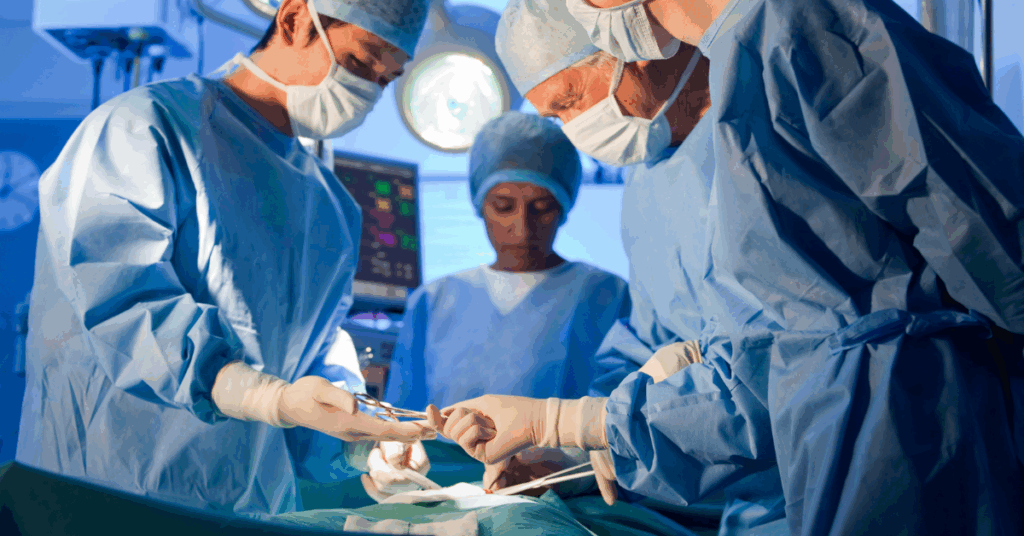
Introduction
Laparoscopic Sleeve Gastrectomy is one of the most common and effective surgical options for long-term weight loss. If you’ve been considering this procedure, it’s natural to feel nervous or unsure about what to expect. This guide will walk you through the entire process, from preparation to recovery, so you can move forward with confidence and clarity.
What Is Laparoscopic Sleeve Gastrectomy?
Laparoscopic Sleeve Gastrectomy, also called sleeve surgery, is a type of weight loss surgery that reduces the size of your stomach. During the procedure, approximately 75–80% of the stomach is removed, leaving a narrow “sleeve” or tube-like structure. This helps reduce hunger and calorie intake, making it easier to lose weight.
Unlike gastric bypass, this surgery does not involve rerouting the intestines. The procedure is done laparoscopically, which means small incisions and a faster recovery time.
Is Sleeve Surgery Right for You?
You may be a good candidate for gastric sleeve procedure if you:
• Have a BMI of 40 or more
• Have a BMI of 35 or more with weight-related conditions like diabetes or high blood pressure
• Have tried to lose weight through diet and exercise with no lasting results
• Are ready to commit to long-term lifestyle changes
Your doctor will run medical evaluations to ensure that this surgery is safe and appropriate for your situation.
Preparing for Laparoscopic Sleeve Gastrectomy
Before you undergo Laparoscopic Sleeve Gastrectomy, there are several important steps you need to take.
Medical Assessments
You’ll likely have blood tests, a physical exam, and possibly heart or lung evaluations. These are meant to check for any conditions that may interfere with surgery or healing.
Nutritional Counseling
A registered dietitian will guide you through preoperative dietary changes. You may need to follow a liquid diet for a week or two before the operation to shrink your liver and make the procedure safer.
Psychological Evaluation
Because surgery is only one part of the journey, many clinics require a mental health screening to make sure you’re emotionally ready for the changes ahead.
Medication Adjustments
Some medications may need to be paused or adjusted prior to surgery. Inform your surgeon about any over-the-counter or prescription drugs you’re taking.
Smoking and Alcohol
Before undergoing Laparoscopic Sleeve Gastrectomy, your medical team will ask you to stop smoking at least 6 weeks in advance. They will also recommend avoiding alcohol, as it can increase surgical risks and interfere with your recovery.
What Happens on Surgery Day?
On the day of your Laparoscopic Sleeve Gastrectomy, you’ll check in early and be prepared by a nurse. You’ll then meet with your anesthesiologist and surgeon before being taken into the operating room. The procedure is performed under general anesthesia and typically takes about 60 to 90 minutes. The surgeon will make a few small incisions and use a laparoscope, a tiny camera, to guide the operation. During Laparoscopic Sleeve Gastrectomy, the surgeon removes most of your stomach and staples the remaining portion into a narrow sleeve shape. After the surgery, medical staff will monitor your vital signs in the recovery room as you wake up. Most patients stay in the hospital for one to two nights, during which you’ll start sipping clear liquids and walking to encourage healing and reduce the risk of blood clots.
Post-Surgery Recovery After Laparoscopic Sleeve Gastrectomy
Recovery after Laparoscopic Sleeve Gastrectomy is gradual but manageable. Most people return to regular activities within 2–4 weeks.
The First Few Days
Expect some pain around the incision sites and in your shoulders (from gas used during the surgery). Pain meds and walking help relieve discomfort.
You’ll start on a clear liquid diet, moving to protein shakes and broth. Staying hydrated is crucial, aim for small sips every few minutes.
The First Month
Your diet will shift through stages:
- Clear liquids
- Full liquids
- Pureed foods
- Soft foods
You’ll work closely with a dietitian to reintroduce solids safely. It’s important to eat slowly, avoid drinking with meals, and stop eating when full.
Returning to Work and Physical Activity
Long-term lifestyle changes are essential for lasting success after Laparoscopic Sleeve Gastrectomy. The surgery is a powerful tool, but real results depend on your daily habits. You will need to adopt new eating behaviors, such as consuming smaller portions, prioritizing protein, and avoiding sugary or processed foods. Drinking enough water throughout the day is also important, but you should avoid drinking during meals. Taking daily supplements like multivitamins, calcium, and vitamin B12 may be necessary to prevent nutritional deficiencies. Emotional support is another key factor. Many people benefit from therapy or support groups to navigate challenges like stress eating or body image changes. Regular follow-up appointments with your healthcare team will help you stay on track, monitor your progress, and adjust your plan as needed. These lifestyle changes are not temporary, they are part of a new, healthier way of living.
Expected Results
Most patients lose between 50 and 70 percent of their excess weight within the first 18 to 24 months after Laparoscopic Sleeve Gastrectomy. The exact results depend on how closely you follow the recommended lifestyle changes, including diet, exercise, and regular follow-ups. In addition to weight loss, many patients experience significant improvements in obesity-related health conditions. These may include better control or even remission of type 2 diabetes, lower blood pressure, reduced symptoms of sleep apnea, relief from joint pain, and improvements in fertility and hormonal balance. These health benefits often lead to a better overall quality of life.
Potential Risks and Side Effects
Like any surgical procedure, Laparoscopic Sleeve Gastrectomy carries some risks. Common complications include bleeding, infection, blood clots, and leakage along the staple line of the stomach. Some patients may also experience acid reflux after surgery. In the long term, patients may develop vitamin and mineral deficiencies, especially if they do not take supplements consistently. Rapid weight loss can also lead to gallstones. However, proper medical care and regular follow-up appointments help manage most of these risks effectively. Understanding these potential side effects in advance helps you prepare and make informed decisions about your health.
Comparing Sleeve to Other Weight Loss Surgeries
Many patients compare Laparoscopic Sleeve Gastrectomy to other bariatric surgeries like gastric bypass or gastric banding. Unlike gastric bypass, sleeve surgery does not involve rerouting the intestines, which reduces the risk of complications such as dumping syndrome. While gastric bypass may result in slightly greater weight loss, sleeve gastrectomy has fewer long-term nutritional deficiencies. Compared to gastric banding, sleeve surgery does not require the placement of a foreign object and tends to offer more consistent and lasting results. Each option has its pros and cons, and your medical team will help you decide which procedure is best for your goals and health status.
Tips for a Successful Outcome
Achieving long-term success after sleeve surgery requires commitment and consistency. It is important to follow your diet plan closely, especially in the first few months. Focus on high-protein foods, eat slowly, and avoid high-sugar or high-fat meals. Regular physical activity is essential, even if it starts with short walks. Tracking your progress with a journal or app can help you stay motivated and identify areas that need improvement. Emotional support, whether through therapy or support groups, can make a big difference as you adjust to your new lifestyle. Staying in close contact with your medical team ensures you receive the guidance and accountability needed to reach your goals.
